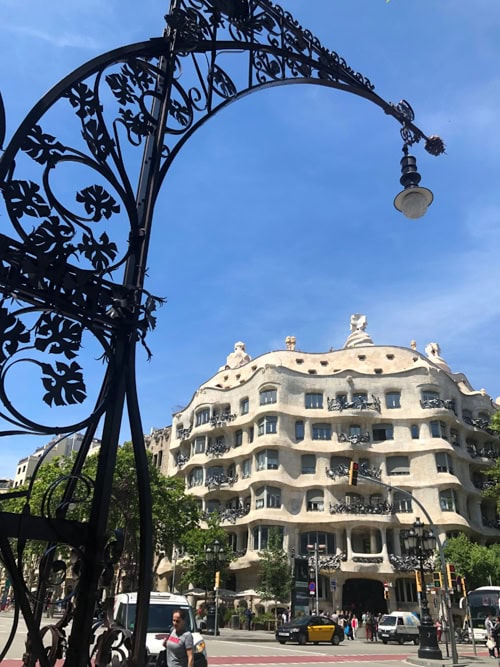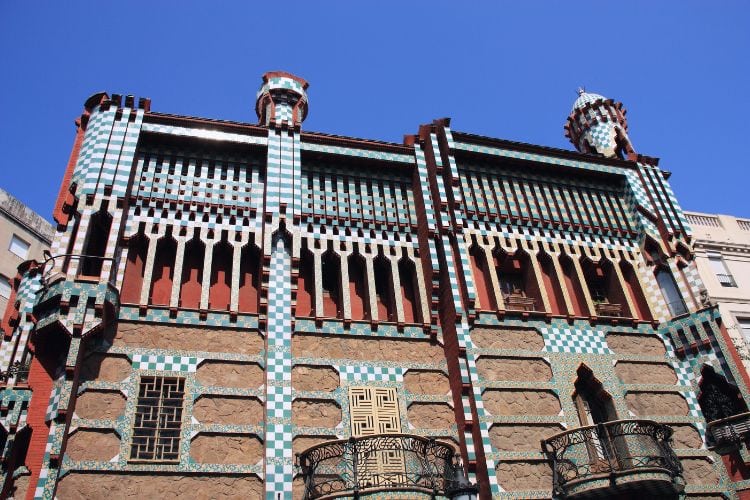
Go World Travel is reader-supported and may earn a commission from purchases made through links in this piece.
Barcelona, the capital of the Catalonia region in Spain, is one of the most popular tourist destinations in Europe. People worldwide flock to eat, explore and enjoy the cosmopolitan vibe of this second-largest city of Spain.
And if you are a fan of architecture and art, Barcelona will fulfill your wishes with world-class examples. This is where to go to see the works of Antoni Gaudi, the Catalan modernist architect and designer.
Gaudi – An Introduction

Photo by Susmita Sengupt
Antoni Gaudi i Cornet was born in Catalonia in 1852 to parents of humble means. He helped his father and grandfather in the family workshop, where the seeds of his creativity were first seen.
Due to his delicate health, Gaudi spent a large part of his childhood recuperating in his summer home. Here he would absorb the beauty and secrets of nature that led to his thought of nature as the “ultimate Creator.”
Around 1869/70, Gaudi went to Barcelona to study design and architecture. Even then, Barcelona was Spain’s most modern city as well as its intellectual, political and cultural capital.
Best Tips & Tools to Plan Your Trip
Though Gaudi already showed signs of brilliance, he was also an unpredictable student. When he completed his degree at the School of Architecture in 1878, its Director said famously, “I do not know if we have awarded this degree to a madman or a genius, only time will tell.”
The landmark buildings designed by Gaudi in Barcelona are where most of his work is concentrated. You will find that his creations are a splendid synthesis of a variety of 19th-century design school thoughts such as the Arts and Crafts movement, Expressionism, Rationalism and early Modernism. Furthermore, his works, which includes seven buildings, are a UNESCO World Heritage Site. Most of these were inscribed in 1984.
Start at Park Güell

To start on the Gaudi architectural delights tour, you can begin at Park Güell. The famous park is located at Carmel Hill in a mountainous region of Barcelona. Built between 1900-1914, the park was officially opened to the public in 1926.
Park Güell was conceived by Gaudi during his “naturalist” phase when he was inspired by natural and organic shapes. The park is named after Eusebi Güell, a textile businessman born in Barcelona in 1846. Eusebi became a lifelong friend and patron of Gaudi.
Güell and Gaudi envisaged Park Güell as a garden city based on the British movement that would support a housing community.
Head to this magical, colorful place to immerse yourself in the beauty of nature, such as winding paths bordered by trees and flowers. And, of course, the inimitable style of Gaudi.
Climb the mini mountain Calvary for a view of Barcelona city and see the stone passage. Then go to The Terrace (which has a separate entry fee) to admire the city view and the colorful mosaics representing a serpent.
Equally mesmerizing is the mosaic salamander that can be seen in many Park Güell photos. Lastly, stop by the Gaudi Museum, the house where Gaudi spent the final 20 years of his life.
Visit Casa Batlló

Photo by Susmita Sengupta
Located in central Barcelona on the major commercial avenue Passeig de Gràcia, Casa Batlló is a Gaudi masterpiece that started as an apartment building. It was bought in 1903 by Josep Batlló, a Catalan textile industrialist. Batlló hired Gaudi to demolish the house and build him a new one.
Gaudi convinced him otherwise and Batlló agreed to a renovation. The result is arguably Gaudi’s prettiest creation. It’s a wonderful example of Modernisme or Catalan Art Nouveau. The house embodies his creative genius as he took his inspiration from nature.
For our visit, we opted to buy timed tickets online the previous day to avoid a long wait. Our visit started as we got out of our taxi to admire the exterior of Casa Batlló, which is like a glamorous jewel in itself.
The broken tile-encrusted facade shimmered colors of blue, green, orange and yellow. Plus the curving and undulating frontage with balconies and the whimsical inverted bell-like roof turrets made the place seem like something from a fairy tale.
Once inside, the tour takes you from floor to floor and each is a revelation of Gaudi’s brilliance. We reveled at the lush forest-like interior of the first floor which made it seem we were surrounded by plants.
The main floor, or the noble floor, has skylights like tortoise shells. We were mesmerized by the ocean-like aura of the blue tiles that ran the entire length of the building atrium. We had to stop at every door, window and railing to admire the whimsical details.
The roof of the house is also a major attraction as it is popularly known as the “dragon back design.”
Enjoy La Pedrera

Casa Mila or “La Pedrera”, as it is popularly known, was the last private house designed by Antoni Gaudi. Also located on Passeig de Gràcia is La Pedrera, built between 1906 and 1912. It is also known as “The Stone Quarry” because of its rough-hewn appearance. It is definitely one of the most imaginative houses I’ve ever seen.
Once again we purchased early timed entry tickets as crowds at these places are quite formidable. Also once again, our experience commenced the moment we set our eyes on this towering masterpiece as we left our taxi.
The sculptural, spectacularly undulating stone facade will stop you in your tracks. There are 32 balconies with beautiful wrought iron grilles and railings made from scrap iron.
The rooftop of Casa Mila is an architectural showstopper and also needs enough time to visit. Of particular note are the superb ventilation towers and chimneys, each a sculptural piece in itself.
Walk around the rooftop admiring the beauty and order of these structures while enjoying the spectacular view of Barcelona city.
And of course, you cannot miss anything in the interior of this glorious building. The basement garage is the first of its kind for a residential building and the courtyards bring in maximum natural light for the 16 apartments that make up La Pedrera.
Other highlights include the magnificent wall paintings and tapestries and the nature-inspired designs of each of the apartments.
Stop by Casa Vicens

Soon after Antoni Gaudi completed his architecture studies, he was commissioned by Manuel Vicens in 1883 to build a summer residence for himself and his wife. Casa Vicens, finished in 1885 is thus the earliest example of Gaudi’s talent. The house is small with just a basement, a ground floor and two upper floors.
The facade is beautiful with the checkered pattern of green and white ceramic tiles on a red background giving it the look of a gingerbread house.
Inscribed as a UNESCO World Heritage Site in 2005, this house shows the strong influence of Asian and Islamic architecture on Gaudi when he began his career.
Today at this museum you can tour the house to see the palm trees, dates on the ceiling and the papier mache tiles in gold, blue and green. There are also a variety of plant motifs throughout.
Gaudi designed the furniture inside and collections of paintings were made specifically for the house. Visiting the rooftop is important as this was the first of the classic Gaudi rooftops you see in his more famous later designs.
Be Awed by La Sagrada Familia

Complete your Gaudi architecture tour with a detailed visit to Basilica de la Sagrada Familia. This is the crowning glory of them all. This symbol of Barcelona is unquestionably the prime tourist attraction of this city.
La Sagrada Familia is the most prominent example of Catalan Modernism and was declared a basilica by Pope Benedict XVI in 2010. In the design of this church, Antoni Gaudi reached the pinnacle of his belief that nature is the embodiment of God.
The church was first envisioned by Josep Bocabella, a local bookseller. He hired an architect who designed a neo-Gothic building in 1882. After disagreements between the two, Gaudi took over the project.
This phenomenal design masterpiece is still incomplete and is slated for completion in 2026, the anniversary year of Gaudi’s death.
We began at a small park across from the church to get photos of the basilica. We were not the only ones. The park was inundated by like-minded tourists who all came to see how Gaudi combined the story of the Bible with organic symbols and shapes.
Tip: For your visit to La Sagrada, you must buy your tickets early.
Inside the Basilica

Photo by Susmita Sengupta
After you’ve admired the amazing facades that highlight the Nativity, Passion and Glory (the yet-to-be-completed facade) stories of Christ, head into the gorgeous interior of the basilica.
Five naves result in a cavernous space supported by angular treelike pillars that transport you into a forest. The space is lit by breathtaking stained glass windows. We stood mesmerized. Our heads upturned, gazing at the magnificence of the ceiling details and rainbows of light pouring in from all sides.
Read More:
Author Bio: Susmita Sengupta, an architect by background, from New York City, loves to travel with her family. She writes frequently for Go World Travel and other online travel magazines such as GoNomad, Matador Network, Travel thru History, In the Know Traveler and others.

